The Cuba Diaries
Sunday, March 13, 2016
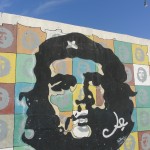
Havana, March 4-12, 2016. — You learn a little something about Cuba before you even board the airplane in Miami. The Cubans who are allowed to visit the States return with giant plastic-wrapped bundles of goods they can’t buy at home. They have car parts, laptop computers, big flat screen televisions, and bicycles. One man checked in with a rack and pinion steering system in a long box. Large unidentified bundles are wrapped in plastic so they don’t get rifled by baggage handlers arriving in Cuba.
We were warned that things go wrong in Cuba. On landing in a Havana Air jet at Jose Marti airport, it took mechanics 45 minutes to open the door and let the passengers out. In Cuba you go through airport security entering the country. They put you through a screening machine and pat you down.
It took about three hours to clear the airport. Half of our party had to wait an hour to get their luggage because a 55-inch television screen had jammed the conveyor.
The road into Havana is lined with Soviet era industrial buildings, many of them abandoned. When the Soviet Union broke up Cuba was lost its Russian subsidies and the industrial economy crashed. They call it “The Special Period. Suddenly food, fuel, parts, and everyday items were more difficult to get. The had power blackouts up to 16 hours a day, but they survived. A sign on a roadside fence said, “socialism or death.”
Traffic is light and brand new Chinese passenger buses share the road with American cars from the 1950s and 60s. It’s the cliché to note that Cuba has these old cars, but it is surprising how many of them there are, and that they are used as everyday transportation. They have Buicks, Chevys, and Cadillacs with big rounded curves and tail fins. The legend is that when the car owners left Cuba during the Revolution, they took their keys with them and some of the old cars are permanently hotwired.
Our local guide is Pavel, who speaks near flawless English, as well as Russian and German. His name is Russian-influenced from the days of the Russian presence here. Pavel is young, handsome and very smart. He learns about America by watching television shows over the Internet. Pavel likes Jimmy Kimmel, Stephen Colbert, and Conan O’Brien is his favorite. “I love that guy, he’s very funny.” Pavel says Jon Stewart should be president and he thinks Donald Trump has gotten too far in the American elections.
The Baseball Argument
Most days in Havana’s Parque Central a group of men stands in a huddle passionately talking, gesturing, and arguing. They aren’t talking politics. The subject is baseball, the national sport and obsession of Cuba. It’s a little unusual, but even more so because they are licensed by the government to go to the park and argue. No big public discussions here about anything unless the government approves.
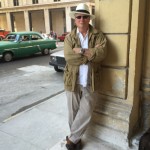
(Robin Groth Photo)
Most of the news here in Cuba is good news, which is not to say that all the news is really good, but the news that’s reported is good. It’s common in a country in which the press is controlled. The lead story on the front page of the Granma International newspaper is about a festival to celebrate the 50th anniversary of the Cohiba brand cigar.
The paper is named after the white motor yacht that brought Fidel Castro and his original cadre of revolutionaries from Mexico to Cuba. Other stories are about how Cuban athletes are hopeful about the Rio Olympics and that Cuba is a leader in neuroscience medicine. They don’t have American political knife fights here. According to one headline, leaders are looking forward to the 7th Party Congress, where, according to the story, greater representation will be guaranteed for all Communist Party members.
The one spot of bad news on page five is that a single case of the Zika virus has showed up in Cuba. A Venezuelan doctor, a woman, came to Cuba in February with the disease.
Cuba Before McDonalds
The first hint of how Cuba works is at the airport. While foreigners wait at the money exchange, a man works the line offering people with American dollars a better rate. He sends them over to a woman who actually works for the exchange, but takes customers into a side door where the transaction takes place in private. They take a little bit of skim from the difference between the official rate and they rate they give.
Cuba has two economies; the official economy, and the economy upon which Cubans survive. A typical worker paid by the government gets the equivalent in Cuban pesos of $25-$30 US dollars a month, which is not enough, but no one pays rent, there are no income taxes, and healthcare is free. Families with babies are given an allotment for formula and diapers. Everyone gets a monthly ration of some basic food items they pay for in pesos; rice, beans, chicken, cooking oil. It’s enough for about 10 days.
To get by, everyone needs to find a way to make more money, preferably in the foreign exchange currency, the CUC, known as the “kook.” The poverty feeds corruption, like the little operation at the currency exchange. Construction materials disappear and money must change hands to grease dealings with government.
Cuba has a culture of tipping. If you take a picture of a man sitting in his old American car, it’s a good idea to give him one kook. A man playing a horn in the street — if you stop and listen you tip him. Many of the bars and restaurants have bands that pass a basket after each set.
A man gave us a tour of an old mansion under repair and we tipped him a few kooks. Then he asked if he could have the pen in my pocket.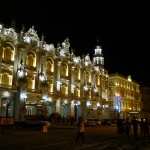
Cuba is a poor country sitting on a wealth of beauty. Old Havana is a 100-year-old city preserved mostly as it was. It has miles of colonnaded buildings with balconies and carved ornaments. The beautiful colonial age buildings are crumbling and dirty. The entire town needs a steam cleaning.
The city has no billboards, no assault of advertising, no fast food joints. Havana has no giant shopping malls selling luxury goods no one needs. There are just a few neon signs, just enough to give character. Some buildings are being gutted and completely re-done. You can see the transformation that’s coming. And the buildings that have been completed are breathtaking. The national theater, lit up at night, looks like Paris.
Cigaronomics
Making a Cuban cigar is like making wine. They make them by hand at the H. Upmann factory in Havana, about 20,000 a day.
Every cigar has five different leaves in it, and the blend master, like the winemaker, chooses them. Shade grown leaves are used for wrappers. The leaf from the top of the plant is for taste, the middle for aroma, the near bottom to make the cigar burn, and the very bottom is for binding.
The leaves are dried and fermented by keeping them slightly moist. The fermenting gets rid of the excess nicotine. And the leaves are aged between nine months and two years — for special cigars, up to five years.
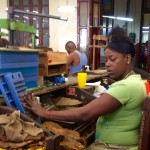
(Mark Litke Photo)
Havana has five cigar factories and together they make 80 million cigars a year for export. The cigar is Cuba’s fourth largest export item.
The Upmann factory, founded by a German in 1844, is in a grand old colonial style building. The workers sit at 50 to 60 year old wooded tables and hand screw presses. A good roller makes 80 to 100 cigars a day.
It’s a case study of how Cuba works. The employees are paid the standard of roughly $30 a month. Each worker is given at least four cigars a day to sell on the black market and steals at least 10 more. Our guide tells us that everyone knows this goes on, even the government and the manager. “The manager steals the most,” he says. One of the cigar rollers furtively offered to sell a bundle of cigars to our staff photographer, Mark Litke, for about 20 kooks — very cheap.
Our guide is blunt about how life works here. “Nobody lives on their salary in Cuba,” he says. “Everything works in the black market.” Not only does no one live on their salary, but you have to do a little extra to make life work for you. Medical care is free, but it’s a good idea to grease the doctor. A gift of cooking oil, canned tomatoes, soap, or detergent will get you better attention.
Working in the cigar factory, though, is a prestigious and coveted job. The workers have a quota for the number of pieces and cigars they complete a day, and get a bonus for any extra. Plus, of course, what they can steal.
It is tradition for one of the workers to sit at the front of the room in the morning and read the newspaper to the cigar roller. In the afternoon, as was done long ago, the reader recites works of literature, and that is how some of the famous cigar brands got their names like Montecristo and Romeo y Julieta.
Crumbling Splendor
Havana is a city of crumbling architectural splendor with laundry hanging to dry on the balconies. They don’t have the money to paint, clean or maintain their colonial era buildings. They have no billboards because they have little to sell, and barely any garbage in the street. Cubans are too poor to have much to casually throw away. They are not rich enough to cast off fast food wrappers and disposable coffee cups. They don’t have them.
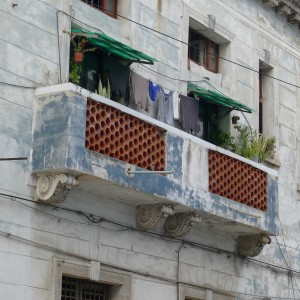
Plumbing is a challenge in Cuba. The streets are often wafting in the odor of sewage. In our hotel, the plumbing system cannot accept paper of any kind. One night the toilets in two rooms exploded, spraying sewage on the walls.
Our group met with Manuel Yepe, a lawyer, economist, and Cuba’s former ambassador to Romania. He was a member of the underground known as a “clandestine” in Havana during the Revolution. He said that despite all of Cuba’s deprivations, “The last thing you lose is hope.”
Cuba has been under a forced economic embargo and blockade since 1959. While the American government does business and has normal relations with China, Russia, Egypt and a long list of countries ruled by dictators and autocrats, the land of rum and street dancing is treated like a dangerous enemy. Yepe said it’s not just that America is blocking Cuba, but that the US bullies any country or company that tries to do business with Cuba. He said the US tells them, “Close your businesses in Cuba or you will lose your American partners.”
Now, President Obama and even the Rolling Stones are coming to Cuba. Cubans are excited and it’s hard to say which visit excites them the most. Yepe and everyday Cubans are looking forward to normal relations with the US, and a chance to improve their lives. “I’m sure things would be better better, much, much better, Yepe said.
Everyday Cubans appear to love Americans despite what the American government has done to isolate and degrade their country. They say “We love America,” and give you a thumbs up. Even those who privately complain about being poor and having no freedom, say they love America, although part of their troubles stem from the economic embargo.
Yepe said Cubans separate Americans from their government. Cubans blame the US government for their troubles, but not Americans. He said Cubans look upon the Americans who come to visit as people who are defying their own government.
Yepe told us that Cuba looks forward to normal relations while continuing to live under its own system. When the assault of American investment comes, he said, Cuba will pick and choose what it wants for its own interest. “We will not be making millionaires, but making the people better.” They’ll have their hands full. McDonald’s and Starbucks will want to be on every corner.
At night we met with Roberto Chile, who spent 25 years as Fidel Castro’s personal photographer. He travelled all over the world with Fidel and he says Fidel is an easy guy to work with.
But the interesting thing here is that you don’t see Fidel’s image many places. It’s not like China under Mao or Iraq and Saddam Hussein. The most common face on graffiti art, t-shirts, and photographs is Fidel’s lieutenant Ernesto “Che” Guevara, who was killed spreading revolution in Bolivia. Asked why Che is so popular, Chile said, “It’s like the Beatles. John Lennon is the most popular Beatle because he died young.”
Chile told our translator there was something he wanted to say. He said “The feelings of Cuban people toward America is friendship … the government is another thing.” Then he gave each of his five visitors a hug.
A Smart Country
Our group took a ride in a 1939 Plymouth taxi the other night. It fit seven people in three rows of seats very comfortably. The driver said the original engine is long gone and the car is now powered by Toyota.
The Cubans have been brilliant about keeping these old cars running. They make new parts and scrounge for old ones. An old American car might have a Korean diesel engine and a Russian transmission. On the streets of Havana there’s even a working Ford Edsel, one of the biggest lemons in the history of the car business.
Some are maintained in mint condition, but for most the original colors are painted over. Fords, Pontiacs, Chevys and Buicks from the 30s into the late 50s are now painted bright blue, orange, gold, red, lime green, pink, and bubblegum.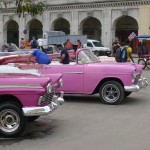
Many are used for taxis and these days you see Western tourists joyriding around Havana in old American convertibles, their video cameras running and selfie sticks high as they hold onto their hats.
Cuba is a country of smart people and they are very proud that immediately after the Revolution Fidel Castro insisted that the 20 percent of Cubans who were illiterate should be taught how to read. They tell the story at the literacy museum on a big military base left by the Batista regime.
The guide says that children, some as young as seven but most of them teenagers, were sent to the country to teach the peasants. Housewives and retired people taught in the city. They say that in just one year the rate of illiteracy was don to 3.9 percent and that today it is .2 percent. In the old days people who learned how to read were encouraged to send their first letter to Fidel Castro.
Education in Cuba is a little ahead of peoples’ ability to do something with it. The big industries are medicine, tourism, biotech, and cigars. Not everyone has a use for their education. In the restaurants and music halls around the Parque Central it’s evident that there’s a good business in prostitution. You see older European men squiring beautiful young black women. They could be the grandfather of their dates. The French, Germans and Italians like the girls with the darkest skin. The girls, teenagers, appear bored staring at their cellphones and barely speaking until the man says it’s time to go to the hotel.
The streets at night are spilling with music. Walk a block or so and there’s a great band playing Cuban music. People just spontaneously dance in the streets.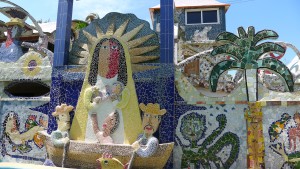
And there is an explosion of art. Our group visited the home of the ceramic artist Jose Fuster, who has covered his home with tiled domes and arches, and ceramic murals of faces and creatures done in cubist style. The steps, the walls, the railings are all tile.
Fuster is working on the rest of the neighborhood. Homes next door and the walls that line the streets are cover with his ceramic art. Fuster’s son translated for his father, “Picasso is my spiritual father and Gaudi is my favorite uncle.”
Moors and Christians
Cuban food is a little bland. They don’t use hot spices and very few herbs. They grill their meats — a lot of pork and chicken. The fish tends to be fried and so are the bananas. Tomato, cucumber, and shredded cabbage are usually served on the side. They make great ice cream and the black beans and rice are known as “Moors and Christians.”
Here is an English language menu item: “Fritos bistec, sprout, Tropical, Roasted to the Juice, Fried masses, Beefsteak, Strips or in Creole Sauce.”
Cuba is a little light on vegetables as well. We visited a large urban farm in a suburban area of Havana where they grow a dozen different vegetables from lettuce to tomatoes, parsley, cilantro, peppers, eggplant and more in rich red dirt. It is the most manicured and orderly garden you ever saw.
After the collapse of the Soviet Union, the Russians pulled out of Cuba and took their economic subsidies with them. The large plot of land where the garden is now was supposed to be the site of a hospital, but the Cubans couldn’t afford to build it. They made the garden instead.
The garden had to be organic because after the Russians there were no chemical fertilizers are insecticides. They choose plants that are somewhat resistant to bugs and place insect repellant plants nearby. They make their own humus in giant troughs of manure crawling with red worms. The vegetables are sold to people in the neighborhood and the government takes 5 percent.
Despite the deprivations, most services Cuba are free. We visited an old age home in a convent with a large interior courtyard. The elderly are up in the morning and out in the street doing exercises. Then they go inside, listen to lectures, and play dominoes all day. There are elementary school classes in the building and a nursery school for children of the employees. The young and the old are mixed. A woman with our group said, “They have shown what you can do with so little, and America has shown what we can do with so much because we choose not to.”
The Socialist Legacy
Cubans often work six days a week, 12 hours a day. Sometimes the waiter who gave you your last Mojito at night is there to serve breakfast in the morning. Our guide Pavel never gets a day off. He picks up a new tour group the same day he takes one to the airport to leave.
But despite how hard they work, some Cubans approach life and work with an attitude that nothing can get better, and nothing will be allowed to get worse. A giant leak in the hotel plumbing will run for 24 hours before anyone cuts it off. The man cooking the eggs in the breakfast line at the hotel may disappear, leaving diners to flip their own eggs.
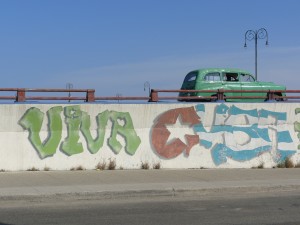
Bank customers are required to wait outside and are allowed inside in ones or twos. One day foreigners waited in a bank line only to be told at the head of it that the bank had no “kooks” to hand out for foreign money. Grocery stores are few and far between and the clothing stores are sparsely stocked.
But Cuba has its strivers. Young men wait outside the popular restaurants, waiting for customers to be turned away. Then they offer to guide the hungry visitors to another good restaurant for a kook or two. Old women in traditional dress smoke cigars and pose for pictures. Men dressed as human statues — a miner, a pirate — work the cameras for kooks.
The lack of commercialism leaves a city in which you can see the buildings. The absence of billboards, posters, and appeals to spend money clears the view. Residents walk down the street with their heads up and talking to each other rather than looking at their cellular devices. They can’t text and surf the net away from a WiFi signal, and WiFi is not universal.
The Cubans are friendly and social. Music spills out of buildings and they break into dance on the street. A local man will take the hand of a tourist woman and dance. Despite their troubles, they can show great joy in life.
The Americans Are Coming
One night at an outdoor restaurant a waiter opened a new bottle of rum and immediately spilled a splash of it to the sidewalk. It was an offering to the Gods of Santeria, the religion African slaves brought to Cuba hundreds of years ago. The Spanish missionaries and lords largely converted the locals to Christianity, but the slaves held on to their Santeria. They’d go to a Catholic Mass and a Santeria ceremony in the same day. Our guide said, “People believe in whatever they think will help them.” Now about 80 percent of Cubans practice Santeria. Occasionally you see a sacrificed chicken on the sidewalk.
Old Havana has a Santeria museum where you can see statues of the gods and they have a lot of them. There is Oricha, the god of chastity and virginity; Oko, “He who has the force of life;” Chango, “He who cuts the violence.”
Cuba has always mixed the old and the new and more of the new is coming. Some large old Spanish colonial buildings are being torn down for luxury hotels and others are being gutted for re-building from the inside.
There’s evidence that Havana is becoming the new Prague or Majorca with young internationals carrying backpacks and wearing hipster fedoras. They hang out in the squares, and bars along Obispo Street between Havana Bay and Parque Central. A restaurant just off the park even offers “glutten free” menu items. The end is near.
The visitors sometimes treat Havana and its struggling residents as the color backdrop for their own adventure. One night a film crew making a guerilla movie charged into a bar shooting their film. They spent 10 minutes on the dance floor while a beautiful blonde European woman and her handsome leading man danced for the camera. She flipped her hair and the camera focused on her swaying hips. The film crew and cast took over the stage.
When they were done, the band gestured for a tip and the film crew stiffed them. The musicians were desperate for money and the Westerners used them for free.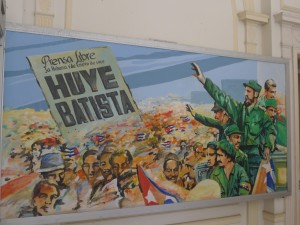
Cubans know change is coming, and they hope for the good. But Americans tend to have the belief that Cubans want to get the hell out of here, and it doesn’t appear to be so. Some tell you there’s no freedom and it’s hard, but many say they love America. They do want things to get better and they look to America for that. They wear t-shirts with American flags and sometimes you’ll see a woman wearing stretch pants with stars and long stripes down the legs. But so far they have been the abused child of American policy.
American corporations are waiting in the wings. Martha Teichner of CBS News reported years ago that, “It’s never stopped being legal for US companies to register their trademarks in Cuba so no one will steal their name and just in case the embargo is lifted one day.
Four thousand companies have done that, 1000 of those only in the last year. Here are some of the names; Hard Rock Café, Ralph Lauren, Fruit of the Loom, Brillo pads, coke, Pepsi, and Visa.”
On the brink of a long overdue change in relations, America is looking at Cuba as a potential market, not a place that needs a lot of help. America wants to convert Cuba’s government and its economy.
The Havana fine arts museum has a famous picture of an Indian rebel about to be burned at the stake by the Spanish Conquistadors. The priest at his side is said to be offering the man a chance to accept Jesus and go to Heaven. According to legend the Indian asked whether the priests and soldiers about to torture him to death would also one day go to Heaven and he was told “Yes, they will.” The Indian said, “I don’t want to be with them. Just burn me.”
It’s an important story in Cuba’s quest for self-determination. We’ll see in the coming years whether Cuba agrees to join America’s capitalistic heaven.
-Brian Rooney
For pictures of Cuba today go to: https://www.facebook.com/TheRooneyReport



Leave a Reply